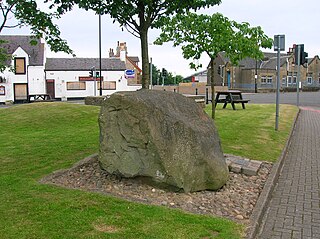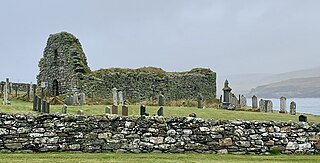
Beachamwell is a village and civil parish in the Breckland district of Norfolk, England about 5 miles (8.0 km) south west of Swaffham and 10 miles (16 km) east of Downham Market. It has four ancient churches, two of them in ruins. The former parish of Shingham has been annexed.

The Eassie Stone is a Class II Pictish stone of about the mid 8th century AD in the village of Eassie, Angus, Scotland. The stone was found in Eassie burn in the late 18th century and now resides in a purpose-built perspex building in the ruined Eassie church.

Kirkinch, meaning 'kirk (church) on the island' in Scots and Gaelic, is a small village in Angus, Scotland. The 'island' is the knoll on which stand the remains of the late 16th century Nevay Church and its medieval burial ground. Nevay parish is now united with Eassie parish. Originally it was an 'island' of slightly higher land surrounded by boggy country. The village houses are adjacent to the knoll, which is encompassed by the wall of the old churchyard. Some of the earliest history of the local area is represented approximately two kilometres northwest at the village of Eassie, where the Eassie Stone is displayed in a modern transparent shelter in the ruined former parish church; this finely carved Pictish cross-slab probably dates to the first half of the 8th century. The church site at Kirkinch is itself probably of early Christian origin. A simple disc-headed cross-slab found here is on display at the Meffan Institute in Forfar.

St Peter's Church is in the village of Heysham, Lancashire, England. It is recorded in the National Heritage List for England as a designated Grade I listed building. It is an active Anglican parish church in the deanery of Lancaster, the archdeaconry of Lancaster and the diocese of Blackburn.

The Church of Saint Andrew is an Anglican parish church located on Turnhill Road, in High Ham, Somerset, England. It shows evidence of 12th- and 14th-century building and was largely rebuilt in 1476. On 17 April 1959, it was designated as a Grade I listed building.

Monkton is a small village in the parish of Monkton and Prestwick in South Ayrshire, Scotland. The town of Prestwick is around 1+1⁄2 miles south of the village, and it borders upon Glasgow Prestwick Airport.

St. Michael the Archangel Church is the oldest building still in use in the city of Southampton, England, founded in 1070. It is the only church still active of the five originally in the medieval walled town. The church is a Grade I Listed building.

Westside Church,, is a ruined 12th century church located on the island of Westray in Orkney, Scotland. Archaeological excavations at the site suggest that the church is related to a nearby late Norse settlement. Historic Environment Scotland established the site, which includes the church and surrounding cemetery, as a scheduled monument in 1921.

Cill Chriosd or Kilchrist is a ruined former parish church of Strath, on the Isle of Skye, Scotland. It was constructed around the 16th century, replacing an earlier medieval church on the same location, and was used until 1840 when the parish church was relocated to Broadford. It lies on the B8083 Broadford to Torrin and Elgol road.

The Church of Saint Laudus is an active parish church in Mabe, Cornwall, England, UK, originally built in the 15th century and dedicated to the sixth-century Saint Laudus of Coutances. It is part of the Church of England Diocese of Truro. Struck by lightning in the 19th century, much of it had to be rebuilt, though parts of the original church remain. It has been a Grade II* listed building since 10 July 1957.

St Michael on Greenhill is a parish church in Lichfield, Staffordshire in England, located on the high ground of Greenhill in the east of the city. A church has been on the present site since at least 1190 but the current building dates mainly from the restoration of 1842–43. The churchyard is one of five ancient burial grounds in England and is one of the largest churchyards in the country at 9 acres (36,000 m2).

St Mary's Church, Llanfair-yng-Nghornwy is a medieval parish church in the north-west of Anglesey, north Wales. The date of foundation of the church, which is in the village of Llanfair-yng-Nghornwy, is unknown, but the oldest parts date from the 11th or 12th century. It has twice been enlarged: in the 15th century, when the chancel was rebuilt, and in the 16th century, when a chapel was added to the south of the chancel, separated by three arches. The tower at the west end is from the 17th century. A south porch of unknown date has been converted into a vestry, and the church is now entered through the tower.

St Piran's Church is an active Anglican parish church in Perranarworthal, Cornwall, England. It is part of a united benefice consisting of eight churches, the Eight Saints Cluster, in the parishes of Stithians with Perran-Ar-Worthal and Gwennap. The benefice has four licensed clergy and four readers. The church, dedicated to Saint Piran, is in the Carnmarth, North deanery, the archdeaconry of Cornwall and the Diocese of Truro. The church was granted Grade II* listed status in May 1967. The churchyard contains several listed chest tombs and headstones.

St John's Church is a ruined church and kirkyard in the parish of Gamrie, Aberdeenshire, Scotland. The church, dedicated to St John the Evangelist, was founded in the 11th century. The existing ruins date from the 16th and 17th centuries. The church was known as the "Kirk of Sculls", from the three Danish skulls taken from the Battle of the Bloody Pits in 1004 AD and displayed in the church until the 19th century. Historic Environment Scotland established the site as a scheduled monument in 1993.

St Olaf's Church, Unst is a ruined medieval church located on the island of Unst, in Shetland, Scotland, UK. The church was built in the Celtic style, and dates to the twelfth century. The burial ground surrounding the church includes several early medieval stone crosses. Historic Environment Scotland first listed the site as a scheduled monument in 1957.

St Boniface's Church, Papa Westray is a historic church and graveyard located on the island of Papa Westray in Orkney, Scotland. The site of the church dates back to the Iron Age and was possibly used later as a Christian monastery. The present church was built in the 12th century and was remodeled in 1710. A 12th-century Norse hogback gravestone lies to the east of the church. Two Pictish cross-slabs were uncovered in the graveyard in the 20th century, and were later moved to museums. Historic Environment Scotland established the site as a scheduled monument in 1959.

St. Mary's Chapel is a ruined 12th century chapel found on the island of Wyre, in Orkney, Scotland. It is thought to have been built by a Norse chieftain, Kolbeinn hrúga or his son, Bjarni Kolbeinsson, Bishop of Orkney. The now roofless Romanesque style building was originally constructed of local rubble and lime mortar. During the late 19th century, the building was restored. Historic Environment Scotland established the site, which includes the church and walled burial ground, as a scheduled monument in 1929.

Lundie Kirk was the parish church of Lundie, Angus, in Scotland from the 12th century until 2017. The church was constructed in Romanesque style in the 12th century and was owned by the Priory of St Andrews for whom it may have served as a rest stop for travelling monks. The church came into the ownership of the Duncan family in 1660. A mausoleum at the east end of the structure was added in 1789 to house the body of Sir William Duncan, 1st Baronet and Admiral Adam Duncan, 1st Viscount Duncan was buried in the graveyard. The church was partly rebuilt in 1846 and a significant renovation was carried out in 1892, converting the mausoleum to a vestry and adding a porch. The church is a Category A listed building.

Eassie Old Church is a ruined 13th-century parish church located near the village of Eassie in Angus, Scotland. Erected in the corner of the church is the Eassie Stone, a Class II Pictish stone. The cross slab was discovered in 1850 in the nearby burn. The church was abandoned after 1835 when a new church was built in the area to serve the combined parishes of Eassie and Nevay. Historic Environment Scotland established the site as a scheduled monument in 1921.

Trumpan Church is a ruined medieval church located on the Isle of Skye in Scotland. In 1578, the church was the site of a brutal massacre of the Clan MacLeod by Clan Macdonald, of South Uist. The attack was in retaliation for the massacre of hundreds of members of Clan Macdonald in the village of Eigg the previous year. The church and surrounding graveyard contain late medieval carved gravestones. Historic Environment Scotland designated the church and surrounding burial ground a scheduled monument in 1936.





















